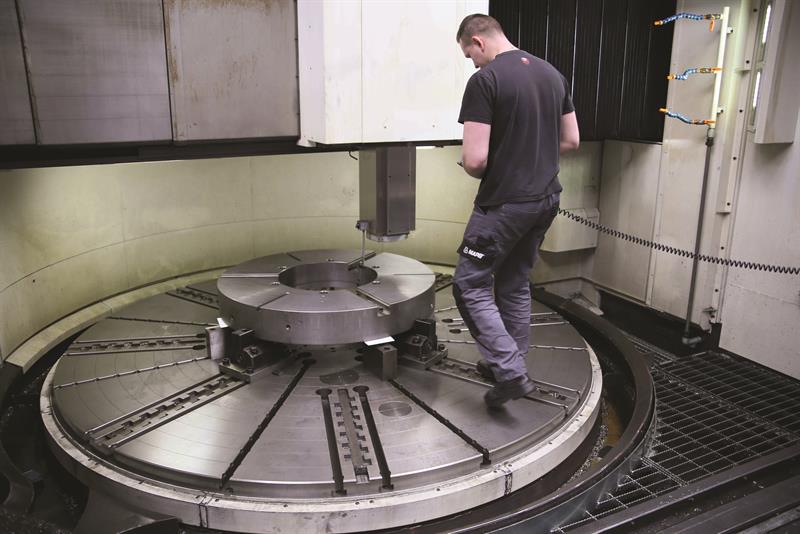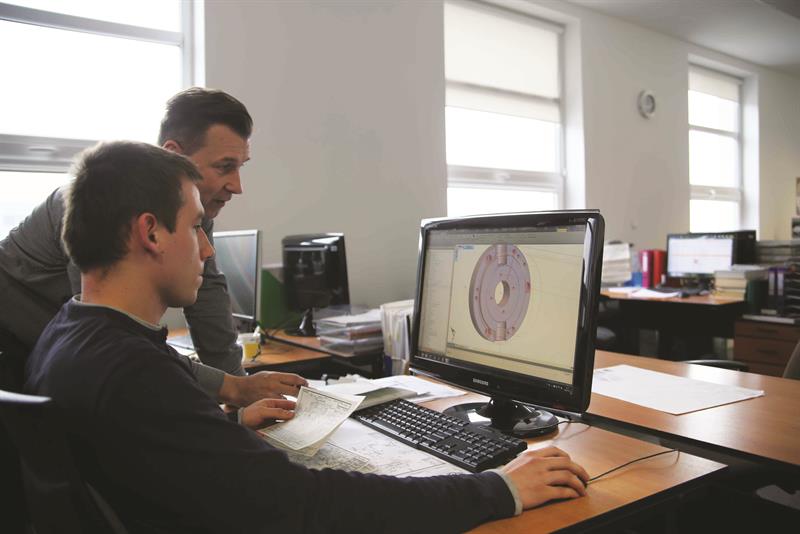Since 2014, Poland-based chuck maker Bison-Bial has installed 40 Okuma (NCMT, 02476 516600) machine tools in its now expanded facility in Bialystok. The machines take in U3000 and U4000 Multus multi-tasking lathes, a double-column VTR-350A multi-tasking centre for parts having diameters up to 3.5 m and lengths up to 2.4 m, plus a multi-tasking 5-axis VTM-2000YB for milling and turning. An MB-1000H horizontal machining centre completes the portfolio of installed Okuma equipment.
Established in 1948 as a clamping tool manufacturer, Bison-Bial (Bison UK, 01733 230567) extended its portfolio to include chucks and now makes products ranging from lathe chucks and lathe faceplates, vices, power chucks and hydraulic cylinders, chuck jaws, VDI toolholders and spindle tooling to milling and indexing fixtures. Custom solutions complement the 20,000-product standard catalogue. Bison-Bial products are cast at an in-house foundry and then processed and finished at the facility.
Although the factory has long had metalcutting capabilities, its machine fleet was not able to adapt to modern production demands. Explains Bison-Bial owner and CEO Jacek Latomski: “Conventional machine tools allowed for high quality manufacturing, but they provided neither the flexibility nor the speed that our production needed.”
That situation started to change in late 2014, when a fleet of 40 new Okuma machine tools began to be installed in a factory that had been expanded by 30,000 m². The bulk of the new machine tools is comprised of multi-tasking turning machines from Okuma’s Multus series, including the U3000 and U4000 models (8-in and 10-in chuck capacities, respectively, with 1,000 and 1,500 mm between centres and maximum swings of 650 and 700 mm).
Bison-Bial sales executive Thomas Bach explains the rationale behind the new machine mix: “The demand for classic lathes has decreased in recent years. Multi-tasking machines allow for turning and cutting operations on a single machine, which increases throughput and flexibility.”
The decision to use multi-tasking machines is rooted in a change in market demands, according to Bach, who adds: “Simple mass production is slowly losing relevance in our industry. Instead, manufacturers need to be able to adapt to their customers’ individual needs.”
Due to the machines’ versatility, Bison-Bial can use multi-tasking Multus U3000 and U4000 lathes to produce a wide range of chucks, as well as custom parts, improving efficiency.
It used to take five machines to achieve what can be done on a single Multus U, says production director Marcin Mysior. “Since everything is done in a single set-up, our entire production has become significantly faster and more flexible,” he reports. For safe machining, the Okuma machines are equipped with the maker’s collision avoidance system to prevent damage to the machine tools.

New workpiece dimensions: Okuma’s VTR-350A, a double-column multi-tasking machine, allows Bison-Bial to manufacture large diameter lathe faceplates
The company was not only looking to optimise established processes, however. In order to expand its product range and to reach new groups of customers, Bison-Bial also invested large part machining capacity. Okuma’s double-column multi-tasking machine VTR-350A handles workpiece diameters of up to 3,500 mm and lengths up to 2,400 mm, enabling the efficient manufacture of very large custom parts.
In addition, the 5-axis vertical multi-tasking machine VTM-2000YB, installed last year, allows for turning and milling operations, as well as for 5-axis processing of large workpieces in a single set-up (capacity: 2,400 mm maximum swing diameter; 1,400 mm maximum turning length;
10 tonne maximum part weight). For the first time ever, Bison-Bial is now able to manufacture lathe faceplates measuring up to 2,000 mm in diameter, as well as other sizable components. With this leap forward in terms of workpiece dimensions, the company says it plans to expand into new markets, such as wind energy.
Another addition to the Bison-Bial factory is the Okuma MB-10000H horizontal machining centre (1,400 by 1,250 by 1,250 mm in X, Y and Z,
and 1,000 mm2 pallet) that is planned to be used for large workpieces and upcoming product innovations. Again, versatility was a deciding factor, as the MB-10000H can easily be adapted by adding flexible manufacturing systems, pallet stations and robots, as changing demands dictate.
With this massive machine tool contract, Japanese machine manufacturer Okuma and its Polish distributor, HTM based in Gliwice, have offered Bison-Bial a package that goes beyond machine delivery and support. In fact, the pair have provided the solution to one of the most pressing challenges that Bison-Bial faced during the factory renovation: skills shortages, caused by the severe lack of qualified operators that results from the poor economic environment that exists in the Bialystok region.

Bison-Bial and the suppliers responded to this problem by establishing an in-house training facility, the Bison-Bial Academy, within which experts from both Okuma and HTM transfer their extensive machine knowledge to new and established Bison-Bial staff (700 people are employed in total). Training is carried out directly on the machines, as well as in a 20-workstation office, where simulation software mimics the Okuma CNC control to allow trainees to learn and practice different machining operations. Only after successfully completing the multi-level training that involves the simulation software do trainees gain certification that qualifies them to operate the Okuma machines.
The OSP-P300 Okuma CNC control also helps less confident staff use the machines. Says Mysior: “The control is intuitive and allows us to perform all operations using only one software application. The visual control panel allows for easy use and more comfortable programming of the individual workpieces.”
Latomski says that labour costs have decreased by 50% with the new machines, whose capital cost is expected to be amortised within three to four years.
The Okuma equipment has enabled the Bison-Bial to establish just-in-time serial manufacture and with production up and running, the company has been developing a variety of new products. “New chuck tools ensure our continued market position as a premium brand for the future,” says sales executive Bach. Indeed, Bison-Bial will present innovations next month at the AMB mechanical engineering exhibition in Stuttgart, Germany, a marketing platform that will help it reach export customers in 70 countries worldwide.
This article was first published in the August 2016 issue of Machinery magazine.




